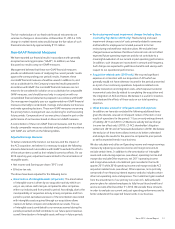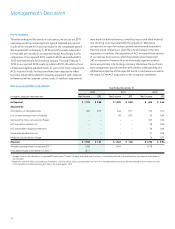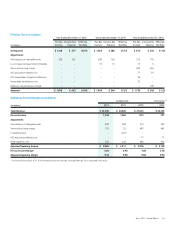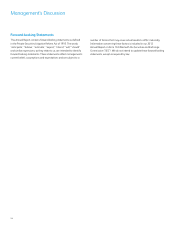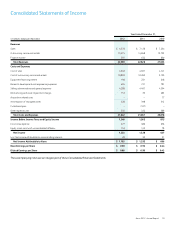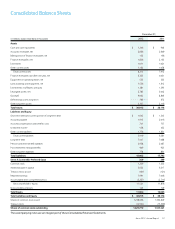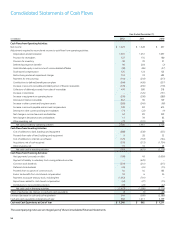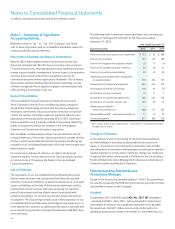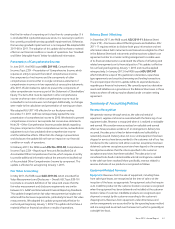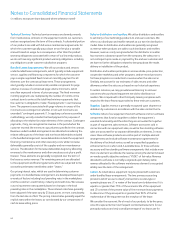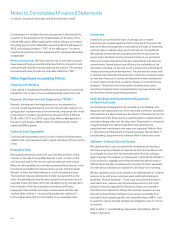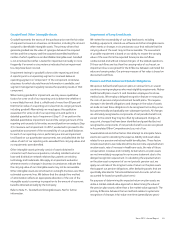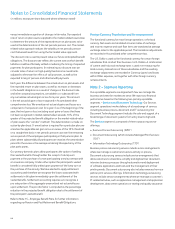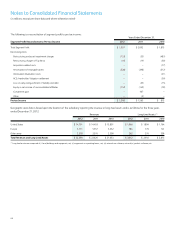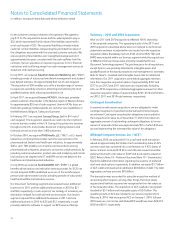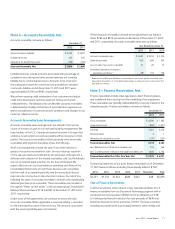Xerox 2012 Annual Report Download - page 63
Download and view the complete annual report
Please find page 63 of the 2012 Xerox annual report below. You can navigate through the pages in the report by either clicking on the pages listed below, or by using the keyword search tool below to find specific information within the annual report.61Xerox 2012 Annual Report
that the fair value of a reporting unit is less than its carrying value. If it
is concluded that a potential exposure exists, it is necessary to perform
the currently prescribed two-step goodwill impairment test. Otherwise,
the two-step goodwill impairment test is not required. We adopted ASU
2011-08 in 2011. The adoption of this update did not have a material
effect on our financial condition or results of operations. See “Goodwill
and Other Intangible Assets” below for additional information.
Presentation of Comprehensive Income:
In June 2011, the FASB issued ASU 2011-05, Comprehensive
Income (Topic 220) – Presentation of Comprehensive Income, which
requires an entity to present the total of comprehensive income,
the components of net income and the components of other
comprehensive income either in a single continuous statement of
comprehensive income or in two separate but consecutive statements.
ASU 2011-05 eliminates the option to present the components of
other comprehensive income as part of the Statement of Shareholders’
Equity. The items that must be reported in other comprehensive
income or when an item of other comprehensive income must be
reclassified to net income were not changed. Additionally, no changes
were made to the calculation and presentation of earnings per share.
We adopted ASU 2011-05 effective for our fiscal year ending
December 31, 2011 and have retrospectively applied the new
presentation of comprehensive income to 2010. We elected to present
comprehensive income in two separate but consecutive statements.
Note 20 – Other Comprehensive Income provides details regarding
the gross components of other comprehensive income, reclassification
adjustments out of accumulated other comprehensive income
and the related tax effects. Other than the change in presentation
and disclosure, the update did not have an impact on our financial
condition or results of operations.
In February 2013, the FASB issued ASU No. 2013-02, Comprehensive
Income (Topic 220) – Reporting of Amounts Reclassified Out of
Accumulated Other Comprehensive Income, which requires an entity
to provide additional information about the amounts reclassified out
of Accumulated Other Comprehensive Income by component. This
update is effective for us beginning January 1, 2013.
Fair Value Accounting:
In May 2011, the FASB issued ASU 2011-04, which amended Fair
Value Measurements and Disclosures – Overall (ASC Topic 820-10)
to provide a consistent definition of fair value and ensure that the
fair value measurement and disclosure requirements are similar
between U.S. GAAP and International Financial Reporting Standards.
This update changed certain fair value measurement principles and
enhanced the disclosure requirements, particularly for level 3 fair value
measurements. We adopted this update prospectively effective for
our fiscal year beginning January 1, 2012. This update did not have a
material effect on financial condition or results of operations.
Balance Sheet Offsetting:
In December 2011, the FASB issued ASU 2011-11, Balance Sheet
(Topic 210) – Disclosures about Offsetting Assets and Liabilities. ASU
2011-11 requires entities to disclose both gross information and net
information about both instruments and transactions eligible for offset
in the Balance Sheet and instruments and transactions subject to an
agreement similar to a master netting arrangement to enable users
of its financial statements to understand the effects of offsetting and
related arrangements on its financial position. This update is effective
for our fiscal year beginning January 1, 2013 and must be applied
retrospectively. In January 2013, the FASB issued ASU 2013-01
which limited the scope of this guidance to derivatives, repurchase
type agreements and securities borrowing and lending transactions.
The principal impact from this update will be to expand disclosures
regarding our financial instruments. We currently report our derivative
assets and liabilities on a gross basis in the Balance Sheet even in those
instances where offsetting may be allowed under a master netting
agreement.
Summary of Accounting Policies
Revenue Recognition
We generate revenue through services, the sale and rental of
equipment, supplies and income associated with the financing of our
equipment sales. Revenue is recognized when it is realized or realizable
and earned. We consider revenue realized or realizable and earned
when we have persuasive evidence of an arrangement, delivery has
occurred, the sales price is fixed or determinable and collectibility is
reasonably assured. Delivery does not occur until equipment has been
shipped or services have been provided to the customer, risk of loss has
transferred to the customer and either customer acceptance has been
obtained, customer acceptance provisions have lapsed or the company
has objective evidence that the criteria specified in the customer
acceptance provisions have been satisfied. The sales price is not
considered to be fixed or determinable until all contingencies related
to the sale have been resolved. More specifically, revenue related to
services and sales of our products is recognized as follows:
Equipment-Related Revenues
Equipment: Revenues from the sale of equipment, including those
from sales-type leases, are recognized at the time of sale or at the
inception of the lease, as appropriate. For equipment sales that require
us to install the product at the customer location, revenue is recognized
when the equipment has been delivered and installed at the customer
location. Sales of customer-installable products are recognized upon
shipment or receipt by the customer according to the customer’s
shipping terms. Revenues from equipment under other leases and
similar arrangements are accounted for by the operating lease method
and are recognized as earned over the lease term, which is generally on
a straight-line basis.


